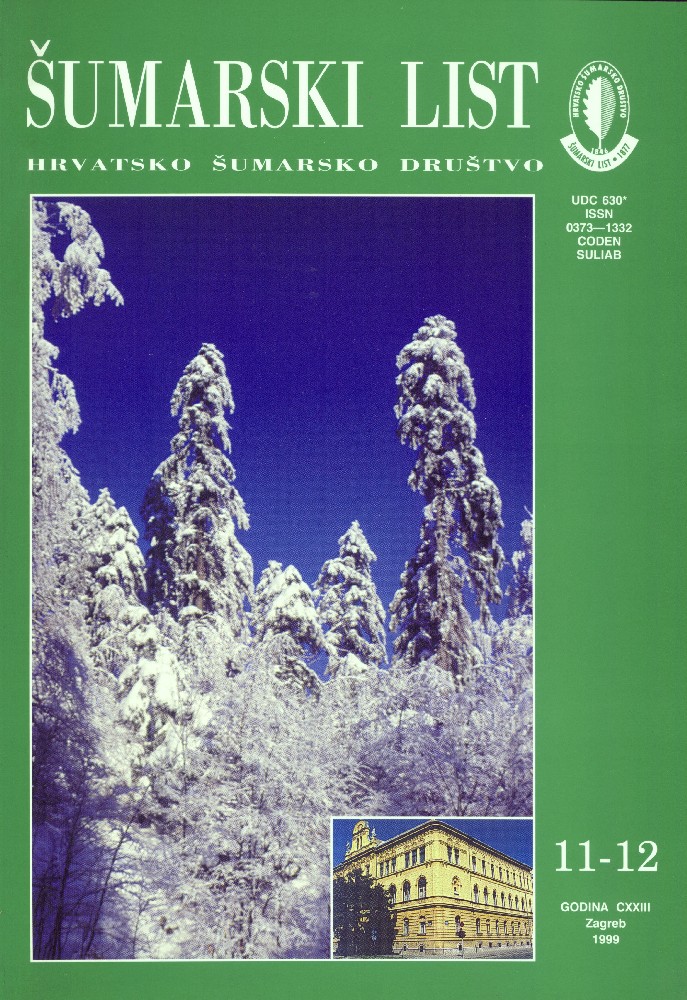| Kajba, D., Bogdan, S., Vratarić, P. | UDK 630* 238 + 114.2 (001) (Salix alba L., Alnus glutinosa (L.) Gaertn.) |
Summary: The aim of this investigation concerning the alder growing in the mixed plantations is to determine the effects of alder-fixed N on the growth of various white willow clones and the selection of genotypes with the best ability of alder- fixed N conversion. It is also important to establish the overall effects of the black alder on the soil and the weed vegetation and to determinate the extent to which alders affect the survival and the production of willow growing in association with them in mixed plantations.The experiment involving the plantation of white willow clones with black alder covers an area of 8.66 ha in the northwestern part of Croatia, in Kloštar Podravski. It was set up in the spring of 1980 with white willow clones, aged 1/2, and black alder, aged 1+1, on the peat-clay soil. The white willow plants were planted at a 4 x 4 m spacing. In this experiment the white willow was represented by 24 clones, of which 12 were planted without the black alder as a control plot.At the plantation age of 8, the white willow and the black alder were felled in portions of the experiment, and after the felling the following test plots were formed.Plot 1 - Salix alba, 12 clonesPlot 2 - Salix alba, 24 clones with Alnus glutinosaPlot 3 - Salix alba, 24 clones, A. glutinosa felledPlot 4 - A. glutinosa, S. alba felledUp to the plantation age 8, the experiment involving 24 (respectively 12) white willow clones, was designed as a randomized block in 4 replications, with 25 plants per small plot. Black alder was represented by plants of local provenance.The experiment of the white willow selected clone growing in the mixed culture with the black alder showed that, with the planting spacings of 4 x 4 m and 4 x 1 m for the white willow and the black alder respectively, the influence of the black alder on the white willow clone production is neglectable during the first five years of plantations age. From the fifth to the eight year of plantation age the influence of the black alder on the white willow clone production in terms of positive modifications is significant. Besides, by the black alder presence the amount of weed vegetation is reduced. From the eighth to the tenth year of the plantation age, the black alder influence on the white willow clone growing is very pronounced in terms of negative modifications. This fact is explained by a very keen white willow - black alder competition, resulting in the reduction of their tree crowns that causes the decrease of increment. At the plantation age of 10 - 13, the number of clones with positive modifications is reduced considerably, while at the age of 15 and 17 years this influence is completely lost. The generally valid rule is that with plantation ageing the number of clones with positive modifications reduces.The arborescent willow clones recommendable for growing in association with the black alder on its habitats in Podravina have been selected, namely: V 161, MB 368, MAđ 40, V 160, Br1BB, S 86, Rep 2, V 99, 11/1 and V 093.To improve the white willow growing in the mixed cultures with the black alder, it is suggested that such cultures are established with a 4 x 4 m spacing for the white willow planting and that in every second row the seedlings are planted at a spacing of 4 x 2 m. The black alder would be planted at a 4 x 1,5 m spacing. The first white willow felling will be done at the plantation age of eight years, and this in the rows with the planting at a 4 x 2 m spacing. The planting spacing of the culture then would be 8 x 4 m for the white willow and 4 x 1,5 m for the black alder. At the plantation age of 15 to 20 years, the felling of all other white willow trees would be done. In this way, after the first felling an intermediate yield of the white willow pulp wood be ensured and sufficient light for an undisturbed growth of the black alder would be provided. By using the high current white willow increment from the eight to the fifteenth or twentieth year, the second intermediate yield in logs for the white willow could be achieved, and after the white willow felling the free development of the black alder as the main culture would be made possible.
Key words: mixed plantations; Salix alba clones; Alnus glutinosa; modification; N-fixation |



